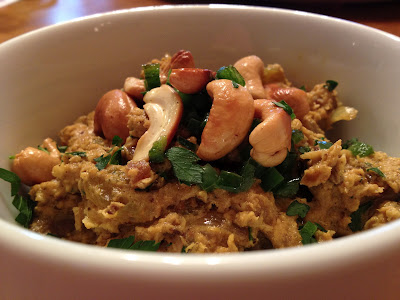The fish recipe, from the Food Network website, was delicious despite falling apart on the grill - we forgot to buy skin-on filets. Oh well! We boiled the leftover marinade for drizzling and we'll probably mix the rest with some cooked rice for a nice side dish. It's just too good to toss out!
As for the onion bhajis, I can't believe it's taken me so long to try them. They're these amazing fritters, both savory and sweet. Bonus: The weather's so mild, I was able to fry them outdoors on the grill's side burner so the house doesn't smell!
The rose water pudding is still a mystery. It hasn't set yet! Rose water such a unique ingredient. (I had some rose water lemonade at a Greek deli in Seattle that was stunningly good.) I've never prepared anything with it personally, so I'm excited to try this treat. I licked the spoon when I finished making it, and I thought it was lovely. Hopefully, after tasting it cold and gelatinized, I'll feel the same! I'll add a comment to this post with the verdict, but it might have to wait till tomorrow.
Speaking of tomorrow, I've got a fantastic destination for the coming week and I'll announce it then. But, once again, I've gotten ahead of myself. Here's how I made tonight's three dishes:
FISH:
½ cup lemon juice
2 Tbsp lemongrass, minced
2 Tbsp garlic, minced
1 Tbsp ginger, grated
1 jalapeño, minced
1 onion, minced
2 Tbsp fresh cilantro or parsley, chopped
¼ cup coconut milk
¼ cup oil
salt and freshly cracked black pepper, to taste
4 white fish filets (mackerel, perch, flounder, etc.), skin on
Combine all the ingredients except the fish in a bowl and mix well. Then, add the fish and marinate for 15 minutes. Grill the fish for about 4-5 minutes per side, starting skin-side up. Baste often with the marinade.
BHAJIS:
¾ cup garbanzo bean (chickpea) flour
1 Tbsp oil
1 tsp ground coriander
1½ tsp ground cumin
1 jalapeño, minced
½ cup warm water
Salt, to taste
2 onions, finely sliced
Fresh cilantro or parsley, chopped, for garnish (optional)
Heat a few inches of oil in a deep pan or fryer to 375°.
Add all ingredients except the onions into a food processor and blend till smooth. Pour batter into a bowl and let sit in a warm place for about 30 minutes. Add the onions and deep fry them like fritters, about 2 Tbsp each, about 5 minutes till golden. Try not to make them too thick or the centers won't cook. Drain well on paper towels, and serve them hot sprinkled with the fresh herbs.
 |
| I bet this pudding will be delicious! |
2½ cups milk
1 envelope (¼ oz.) powdered unflavored gelatin3 Tbsp water
3 Tbsp sugar
2 tsp rose water
Bring the milk almost to a boil in a saucepan over medium-high heat. Meanwhile, sprinkle the gelatin over the water and allow it soften for 2-3 minutes. When the milk is hot, add the gelatin and sugar and stir till completely dissolved. Then mix in the rose water. Remove from the heat and whisk till cooled slightly and frothy. Pour the pudding into either single-serving bowls or a larger one, if desired. Refrigerate till completely set.
Cook's Note: The original recipe for the rose water pudding uses a few drops of red food-coloring to make half the mixture pink. That is poured into the dishes and chilled for about a half hour till partially set. Then the white layer is added, after being kept warm till the pink layer is ready. Then the pudding goes back in the fridge till completely set.










